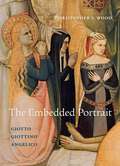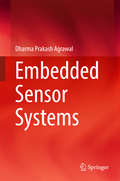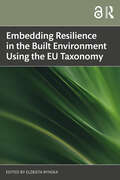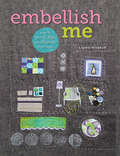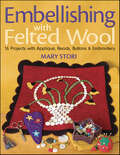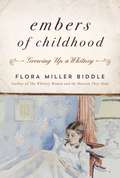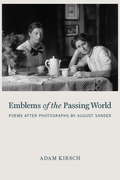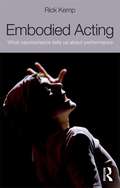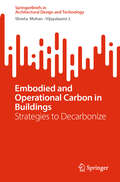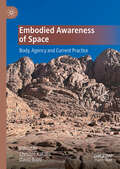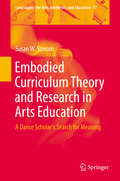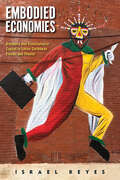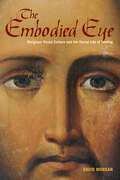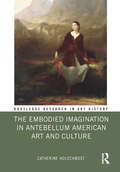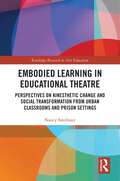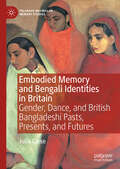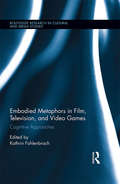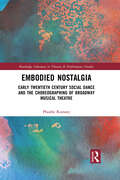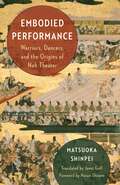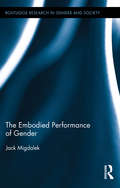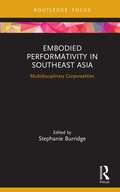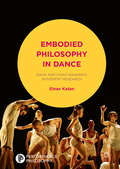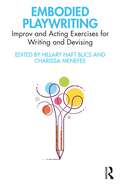- Table View
- List View
The Embedded Portrait: Giotto, Giottino, Angelico
by Christopher S. WoodA new study of the early Renaissance portraitIn fourteenth-century Italy, ever more women and men—not only clergy but also laity—introduced their own portraits into sacred paintings. Images of modern supplicants, submissive and prayerful, shared space with the holy narratives. The portraits mimicked the first worshippers of Christ: Mary, the Three Magi, Mary Magdalene. At the same time, they modeled, for modern viewers, ideal involvement in the emotion-laden stories. In The Embedded Portrait, Christopher S. Wood traces these incursions of the real and profane into Florentine sacred painting between Giotto and Fra Angelico.The portraits not only intruded upon a sacred space, but also intervened in an artwork. The pressure exerted by the modern interlopers—their lives and experiences, implied by their portraits—threatened the formal closure that had served as a powerful symbolic form of the pact between God and humans. The Embedded Portrait reconstructs this art historical drama from the point of view of the artists rather than the patrons. Following clues left by Vasari, the book assigns a leading role to the painter Giottino, or &“little Giotto.&” Little-known today but highly regarded in his lifetime, Giottino proposed a new manner of painting that was later realized by Fra Angelico through his own innovative approach to the problem of the embedded portrait.Seeking not to stabilize the artworks but to extend their reach, the interpretations offered in The Embedded Portrait re-create and update the psychic and libidinal energies that gave rise to these works in the first place.
Embedded Sensor Systems
by Dharma Prakash AgrawalThis inspiring textbook provides an essential introduction to wireless technologies for sensors, explores the potential use of sensors for numerous applications, and utilizes probability theory and mathematical methods as a means of embedding sensors in system design. The book discusses the need for synchronization and underlying limitations, the interrelation between given coverage and connectivity to the number of sensors needed, and the use of geometrical distance to determine the location of the base station for data collection, while also exploring the use of anchor nodes to determine the relative positions of sensors. The book addresses energy conservation, communication using TCP, the need for clustering and data aggregation, and residual energy determination and energy harvesting, together with key topics in sensor communication like mobile base stations and relay nodes, delay-tolerant sensor networks, and remote sensing and potential applications. The book defines routing methods and performance evaluation for random and regular sensor topology and covers sensor-based intrusion detection. The book focuses on applications such as interaction with actuators, final design with respect to a given application, personal and body-area networks for health-care applications and sensor networks as an integral component of the IoT. The importance of both coverage and connectivity is examined thoroughly in both randomly deployed sensor networks for defense applications and regularly placed sensors for an industrial setup. The content includes exercises as well as design-based project concepts. The book's comprehensive coverage makes it well suited for use as a textbook for graduate and upper undergraduate courses, or as course material for professional courses.
Embedding Resilience in the Built Environment Using the EU Taxonomy
by Elzbieta RynskaTaxonomy is the common name for an EU regulation that supports companies in sustainable environmental and climate action (Regulation [EU] No. 2020/852). It is a classification tool designed for investors, companies, and financial institutions to define the environmental impact of business activities and the requirements that organisations must meet to be considered as sustainable.The aim of this book is to examine the EU taxonomy from the built environment perspective and the ways in which it can be used to build resilience in real estate. It presents the issues, hot points, and possible choices from the designers, construction consultants, and investing bodies' points of view, those who must set forth initial conditions, which should later become the keystones for greener developments. It brings together the expertise of a unique team of both researchers and professionals and presents a methodology, case studies, and solutions which together comprise a novel understanding of the taxonomy’s influence on the pre-construction phase. The book:• describes the role of the built environment within sustainable development and how real estate can be used to build resilience with the use of taxonomy.• describes the characteristics of resilient environmentally friendly cities in the future.• proposes a roadmap to demonstrate urban policies that promote decarbonisation; and•enables investors to compare their products, operations, and strategies in terms of sustainability.Overall, this book is essential reading for decision-makers in the public and private sectors, urban developers, space and spatial designers, architects, planners, community stakeholders, and real estate investors.Chapter 1 of this book is freely available as a downloadable Open Access PDF at http://www.taylorfrancis.com under a Creative Commons Attribution-Non Commercial-No Derivatives (CC-BY-NC-ND) 4.0 license.
Embellish Me: How to Print, Dye, and Decorate Your Fabric
by Laurie WisbrunEmbellish Me is the ultimate guide to achieving the perfect surface finish for your fabric-based projects. Comprehensive step-by-step instructions are accompanied by detailed illustrations that illuminate an extensive range of fabric alteration and embellishment techniques. Learn tie-dyeing, bleaching, and shibori; block, silk-screen, and digital printing; and beading, embroidery, and applique. This information-rich guide will equip you with all the information you need to apply these techniques to any number of fabric projects, from tote bags and clothes to cushion covers, lampshades, toys, and home furnishings. Galleries throughout the book will inspire you to engage with these techniques, showing how they have been applied to fabric and providing a valuable starting point for your craft. Divided into three sections, Embellish Me begins with essential information on tools and materials, as well as a comprehensive chapter on pattern design, which covers computer-rendered patterns in addition to hand-drawn designs. The second section is organized by technique, covering bleaching, dyeing, and printing, as well as more complex embellishing techniques such as embroidery, needle punching, and foil embossing. Each chapter concludes with an artist interview, giving you insight into the working practices of contemporary fabric crafters, and providing further inspiration for your own projects. The third section rounds out the book with instructions for crafters who want to take their fabric designs to the next level, and offers in-depth advice on important issues such as how aspiring crafters can best market and sell their own designs.
Embellishing with Felted Wool: 16 Projects with Appliqué, Beads, Buttons & Embroidery
by Mary StoriWild About Wool? You'll Love Making & Embellishing These Cozy Accessories • 16 delightful, decorative wool projects small enough to take with you and work on anywhere • Easy-to-work wool felt - no fraying, no appliqué edges to turn - is even easier with Mary's innovative, foolproof construction and edging methods • Styles and colors include traditional, folk art, contemporary, hip, and cute as a button These charming designs inspired by wool Penny Rugs are simple to put together and fun to embellish. The 16 projects include wallhangings, table toppers, pillows, small purses, scissors sheaths, and business card cases.
Embers of Childhood: Growing Up a Whitney
by Flora Miller BiddleA Look into the Privileged World of the American Aristocracy of the Early Twentieth Century Flora Miller Biddle was born a blue-blood. The granddaughter of the Whitney museum founder, Gertrude Vanderbilt Whitney, her childhood played out in a sort of Wharton landscape as she was shielded from the woes of the world. But money itself is not the source of happiness. Glimpses into the elegance of a Vanderbilt ball thrown by her great-grandparents and the yearly production of traveling from her childhood home on Long Island to their summer home in Aiken, South Carolina, are measured against memoires of strict governesses with stricter rules in a childhood separate from her parents, despite being in the same house, and the ever-present pressure to measure up in her studies and lessons. As Flora steps back in time to trace the origins of her family’s fortune and where it stands today, she takes a discerning look at how wealth and excess shaped her life, for better and for worse.In this wonderfully evocative memoir, Flora Miller Biddle examines, critiques, and pays homage to the people and places of her childhood that shaped her life.
Emblems of the Passing World
by Adam KirschAugust Sander's photographic portraits of ordinary people in Weimar Germany inspire this uncanny new collection of poems by one of America's most celebrated writers and criticsThrough his portraits of ordinary people--soldiers, housewives, children, peasants, and city dwellers--August Sander, the German photographer whose work chronicled the extreme tensions and transitions of the twentieth century, captured a moment in history whose consequences he himself couldn't have predicted. Using these photographs as a lens, Adam Kirsch's poems connect the legacy of the First World War with the turmoil of the Weimar Republic with moving immediacy and meditative insight, and foreshadow the Nazi era. Kirsch writes both urgently and poignantly about these photographs, creating a unique dialogue of word and image that will speak to all readers interested in history, past and present.
Embodied Acting: What Neuroscience Tells Us About Performance
by Rick Kemp‘A focus on the body, its actions, and its cognitive mechanisms identifies ... foundational principles of activity that link the three elements of theatre; Story, Space, and Time. The three meet in, are defined by, and expressed through the actor’s body.’ – from the Introduction Embodied Acting is an essential, pragmatic intervention in the study of how recent discoveries within cognitive science can – and should – be applied to performance. For too long, a conceptual separation of mind and body has dominated actor training in the West. Cognitive science has shown this binary to be illusory, shattering the traditional boundaries between mind and body, reason and emotion, knowledge and imagination. This revolutionary new volume explores the impact that a more holistic approach to the "bodymind" can have on the acting process. Drawing on his experience as an actor, director and scholar, Rick Kemp interrogates the key cognitive activities involved in performance, including: non-verbal communication the relationship between thought, speech, and gesture the relationship between self and character empathy, imagination, and emotion. New perspectives on the work of Stanislavski, Michael Chekhov, and Jacques Lecoq – as well as contemporary practitioners including Daniel Day-Lewis and Katie Mitchell – are explored through practical exercises and accessible explanations. Blending theory, practice, and cutting-edge neuroscience, Kemp presents a radical re-examination of the unconscious activities engaged in creating, and presenting, a role.
Embodied and Operational Carbon in Buildings: Strategies to Decarbonize (SpringerBriefs in Architectural Design and Technology)
by Shveta Mohan Vijayalaxmi J.This book offers the basics of embodied and operational carbon while discussing the inclusion of carbon emission in the GBRS at global and national level. This book also critically explores the important topic of embodied and operational carbon of buildings with insights on the strategies to measure and reduce embodied carbon in buildings through a case study and application approach. This approach assesses the impact of embodied carbon on the choice of structural systems, alternate building materials, alternate building technologies and air conditioning system. The impact of these alternate measures in reducing embodied and operational carbon is analyzed by demonstrating its use on a base case building, which is similar to an existing office building in India. The quantified data enables architects and designers to make early design decisions for a more environmentally sensitive approache to sustainable building designs. This book is a valuable resource for students, researchers, and practicing architects in understanding evidence based repercussions of structural systems, use of materials, technology and air conditioning systems to design green and sustainable buildings.
Embodied Awareness of Space: Body, Agency and Current Practice
by Christos Kakalis David BoydThis edited volume explores the notion of embodied experience through a diverse range of disciplines: architecture, music, literature, performance studies, philosophy, geopolitics. In doing so, it illuminates the need to redefine the role of the human body as one of the protagonists for raising awareness of space-time issues through processing, experimentation and application of histories and theories of embodied awareness of space. Critically revisiting these spatio-temporal dialogues, this book suggests a method of linking theory, history and practice: past, present and future. The authors reinstate the significance of history and theory in creative thinking, and test their applicability in a number of different areas: theoretical and buildable architectural projects, mapping and geography, representation, and performative arts. This volume will appeal to students and scholars from architecture, art, cultural studies, landscape studies, media studies, and other disciplines in the humanities and social sciences.
Embodied Consciousness: Performance Technologies
by Jade Rosina Mccutcheon Barbara Sellers-YoungThis volume of essays combines research from neuroscience, conscious studies, methods of training performers, modes of creating a staged narrative, Asian aesthetics, and post-modern theories of performance in an examination of the relationship between consciousness and performance.
Embodied Curriculum Theory and Research in Arts Education
by Susan W. StinsonThis collection of articles by Susan W. Stinson, organized thematically and chronologically by the author, reveals the evolution of the field of arts education in general and dance education in particular, through narrative and critical reflections by this unique scholar and a few co-authors. It also includes contextual insights not available elsewhere. The author's pioneering embodied research work in arts and dance education continues to be relevant to researchers today. The selected chapters and articles were predominantly previously published in a variety of journals, conference proceedings and books between 1985 and the present. Each section is preceded by an introduction and the author has written a post scriptum for each article to offer a commentary or response to the article from the current perspective.
Embodied Economies: Diaspora and Transcultural Capital in Latinx Caribbean Fiction and Theater (Latinidad: Transnational Cultures in the United States)
by Israel ReyesHow do upwardly mobile Latinx Caribbean migrants leverage their cultural heritage to buy into the American Dream? In the neoliberal economy of the United States, the discourse of white nationalism compels upwardly mobile immigrants to trade in their ties to ethnic and linguistic communities to assimilate to the dominant culture. For Latinx Caribbean immigrants, exiles, and refugees this means abandoning Spanish, rejecting forms of communal inter-dependence, and adopting white, middle-class forms of embodiment to mitigate any ethnic and racial identity markers that might hinder their upwardly mobile trajectories. This transactional process of acquiring and trading in various kinds of material and embodied practices across traditions is a phenomenon author Israel Reyes terms “transcultural capital,” and it is this process he explores in the contemporary fiction and theater of the Latinx Caribbean diaspora. In chapters that compare works by Lin-Manuel Miranda, Nilo Cruz, Edwin Sánchez, Ángel Lozada, Rita Indiana Hernández, Dolores Prida, and Mayra Santos Febres, Reyes examines the contradictions of transcultural capital, its potential to establish networks of support in Latinx enclaves, and the risks it poses for reproducing the inequities of power and privilege that have always been at the heart of the American Dream. Embodied Economies shares new perspectives through its comparison of works written in both English and Spanish, and the literary voices that emerge from the US and the Hispanic Caribbean.
The Embodied Eye: Religious Visual Culture and the Social Life of Feeling
by David MorganDavid Morgan builds on his previous groundbreaking work to offer this new, systematically integrated theory of the study of religion as visual culture. Providing key tools for scholars across disciplines studying the materiality of religions, Morgan gives an accessibly written theoretical overview including case studies of the ways seeing is related to touching, hearing, feeling, and such ephemeral experiences as dreams, imagination, and visions. The case studies explore both the high and low of religious visual culture: Catholic traditions of the erotic Sacred Heart of Jesus, the unrecognizability of the Virgin in the Fatima apparitions, the prehistory of Warner Sallman’s face of Jesus, and more. Basing the study of religious images and visual practices in the relationship between seeing and the senses, Morgan argues against reductionist models of "the gaze," demonstrating that vision is not something that occurs in abstraction, but is a fundamental way of embodying the human self.
Embodied Human–Computer Interaction in Vocal Music Performance (Springer Series on Cultural Computing)
by Franziska BaumannThis SpringerBrief provides a unique insight into the practice and research of the connections between voice, HCI and embodiment. Specifically, it explores how the voice can be embodied and mediated by means of gestural communication through sensor interfaces and aims to situate and contextualise various aspects that generate meaningful connections in such interactive interface performance. The author offers an approach for understanding creative practices between humans and computers in gestural live music performance, from the perspective of the embodied relationships created within such systems. Underlying practices, principles and sensor technologies that support creativity in embodied human-computer interaction in vocal music performance are examined and a dynamic framework and tools for anyone wishing to engage with this subject in depth are presented. The book is essential reading not only for musicians, composers, researchers, application developers, musicologists and educators but also for students and tertiary institutions as well as actors and dramaturgs in a music context.
The Embodied Imagination in Antebellum American Art and Culture (Routledge Research in Art History)
by Catherine HolochwostThis book reveals a new history of the imagination told through its engagement with the body. Even as they denounced the imagination’s potential for inviting luxury, vice, and corruption, American audiences avidly consumed a transatlantic visual culture of touring paintings, dioramas, gift books, and theatrical performances that pictured a preindustrial—and largely imaginary—European past. By examining the visual, material, and rhetorical strategies artists like Washington Allston, Asher B. Durand, Thomas Cole, and others used to navigate this treacherous ground, Catherine Holochwost uncovers a hidden tension in antebellum aesthetics. The book will be of interest to scholars of art history, literary and cultural history, critical race studies, performance studies, and media studies.
Embodied Learning in Educational Theatre: Perspectives on Kinesthetic Change and Social Transformation from Urban Classrooms and Prison Settings (Routledge Research in Arts Education)
by Nancy SmithnerThis book explores embodied teaching practices through applied and physical theatre, drawing extensively on the author’s rich experience teaching in diverse urban environments, including schools, colleges and prison settings.It presents a groundbreaking conceptualization of embodied practice aimed at fostering personal and social growth through educational theatre. Each chapter delves into theories of social transformation, supported by qualitative data from student reflections, to provide both theoretical and practical insights. These insights illustrate how physicalized pedagogy can be effectively used to engage students with socially transformative ideas and identities. It also emphasizes the significant role of the facilitator in this process, highlighting how they can create an environment that fosters ethical and multicultural awareness in both formal educational settings, such as classrooms, and informal settings, like community workshops. By promoting an ethos of inclusivity and ethical consideration, it argues that facilitators can help students navigate and engage with complex social issues through the medium of theatre.An accessible and compelling text, it aims to inspire educators to adopt innovative methods that promote deeper engagement and understanding among students.
Embodied Memory and Bengali Identities in Britain: Gender, Dance, and British Bangladeshi Pasts, Presents, and Futures (Palgrave Macmillan Memory Studies)
by Julia GieseThis book provides insight into the relationship between embodied processes and products of remembering and belonging among British Bangladeshi women in Tower Hamlets, London. Based on an analysis of memories performed in both professional and social dancing among British Bangladeshi women, as well as of the spaces and encounters that enable the production, transmission, and negotiation of such memories, this book addresses questions about the relationship between remembering and identification in the diaspora.
Embodied Metaphors in Film, Television, and Video Games: Cognitive Approaches (Routledge Research in Cultural and Media Studies)
by Kathrin FahlenbrachIn cognitive research, metaphors have been shown to help us imagine complex, abstract, or invisible ideas, concepts, or emotions. Contributors to this book argue that metaphors occur not only in language, but in audio visual media well. This is all the more evident in entertainment media, which strategically "sell" their products by addressing their viewers’ immediate, reflexive understanding through pictures, sounds, and language. This volume applies cognitive metaphor theory (CMT) to film, television, and video games in order to analyze the embodied aesthetics and meanings of those moving images.
Embodied Nostalgia: Early Twentieth Century Social Dance and the Choreographing of Broadway Musical Theatre (Routledge Advances in Theatre & Performance Studies)
by Phoebe RumseyEmbodied Nostalgia is a collection of interlocking case studies that focus on how social dance in musical theatre brings forth the dancer on stage as a site of embodied history, cultural memory, and nostalgia, and asks what social dance is doing performatively, dramaturgically, and critically in musical theatre. The case studies in this volume are all Broadway musicals set during the Jazz Age (1910-1950), however, performed and produced after that time, creating a spectrum of nostalgic impulses that are interrogated for social and political resonance and meaning. All reflect the fractures or changes in the social dance when brought to the stage and expose the complexities of the embodied nostalgia – broadly interpreted as the physicalizing of community memories, longings, and historical meaning – the dances carry with them. Particular attention is focused on the Black ownership of the social dances and the subsequent appropriation, cultural theft, and forgotten legacies. By approaching musical theatre through this lens of social dance––always already deeply connected to notions of class and race––and the politics of choreography therein, a unique and necessary method to describing, discussing, and critically evaluating the body in motion in musical theatre is put forth.
Embodied Performance: Warriors, Dancers, and the Origins of Noh Theater
by 1 Shinpei MatsuokaIn this groundbreaking book, Matsuoka Shinpei—a leading scholar of noh theater—provides a detailed account of the birth of one of Japan’s most celebrated art forms. Although noh has often been associated with the elite, Embodied Performance explores its links to a wider popular culture, revealing a rich and colorful public space where courtiers and commoners mingled.Matsuoka traces noh’s connections to popular and religious dances, linked verse, and chigo (beautiful temple boy) culture, emphasizing performance and the body. He describes the world of noh playwright Zeami as well as his views on dramaturgy and performance—and argues that Zeami was once a chigo. Matsuoka shows how religious rituals and cultural forms like ecstatic dance prayer and plays about demons in hell attracted people on the margins. Such activities, Matsuoka contends, drew on the tension between wild acrobatic movement and corporeal restraint, influencing the development of noh as well as the art of flower arranging and the tea ceremony. Janet Goff’s translation makes available in English a classic work of Japanese scholarship that will be invaluable to those interested in medieval Japanese culture, noh, and theatrical practice.
The Embodied Performance of Gender (Routledge Research in Gender and Society)
by Jack MigdalekNorms of embodied behaviour for males and females, as promoted in mainstream Western public arenas of popular culture and the everyday, continue to work, overtly and covertly, as definitive and restrictive barriers to the realm of possibilities of embodied gender expression and appreciation. They serve to disempower and marginalize those not inclined to embody according to such dichotomous models. This book explores the ramifications of the way our gendered, sexed and culturally constructed bodies are situated toward notions of difference and highlights the need to safeguard the social and emotional well-being of those who do not fit comfortably with dominant norms of masculine/feminine behaviour, as deemed appropriate to biological sex. The book interrogates gender inequitable machinations of education and performance arts disciplines by which educators and arts practitioners train, teach, choreograph, and direct those with whom they work, and theorizes ways of broadening personal and social notions of possible, aesthetic, and acceptable embodiment for all persons, regardless of biological sex or sexual orientation. The author’s own struggles as a performance artist, educator, and person in the everyday, as well as the findings of empirical fieldwork with educators, performance arts practitioners, and high school students, are employed to illustrate and advocate the need for self reflexive scrutiny of existing and hidden inequities regarding the embodiment of gender within one’s own habitual perspectives, taste, and practices.
Embodied Performativity in Southeast Asia: Multidisciplinary Corporealities (Routledge Contemporary Southeast Asia Series)
by Stephanie BurridgeA collection presenting cutting edge research from music, dance, performance art, fashion and visual arts, written by scholar-practitioners working in Southeast Asia. This eclectic monograph explores multi-disciplinarily performativity through the body. Exploring the notion of the body as central to creative practice it draws together conversations centring on innovation through embodied knowledge relating to space, time and place. The authors in this collection are leaders in their field and recognized internationally. Their chapters represent new directions in thought and practice by game-changers in the arts. Underpinned by a central theme of corporeality, it is bold and innovative in its scope and range, bringing diverse disciplines together. It enables connections that create new ways of critically exploring corporeality extending beyond physicality and the traditional body-centred areas of performing arts practice. Insightful and stimulating reading for students, scholars and practitioners across the tertiary arts sector, as well as education, therapy, cultural studies and interdisciplinary arts.
Embodied Philosophy in Dance
by Einav KatanRepresenting the first comprehensive analysis of Gaga and Ohad Naharin's aesthetic approach, this book following the sensual and mental emphases of the movement research practiced by dancers of the Batsheva Dance Company. Considering the body as a means of expression, Embodied Philosophy in Dance deciphers forms of meaning in dance as a medium for perception and realization within the body. In doing so, the book addresses embodied philosophies of mind, hermeneutics, pragmatism, and social theories in order to illuminate the perceptual experience of dancing. It also reveals the interconnections between physical and mental processes of reasoning and explores the nature of physical intelligence.
Embodied Playwriting: Improv and Acting Exercises for Writing and Devising
by Hillary Haft Bucs Charissa MenefeeEmbodied Playwriting: Improv and Acting Exercises for Writing and Devising is the first book to compile new and adapted exercises for teaching playwriting in the classroom, workshop, or studio through the lens of acting and improvisation. The book provides access to the innovative practices developed by seasoned playwriting teachers from around the world who are also actors, improv performers, and theatre directors. Borrowing from the embodied art of acting and the inventive practice of improvisation, the exercises in this book will engage readers in performance-based methods that lead to the creation of fully imagined characters, dynamic relationships, and vivid drama. Step-by-step guidelines for exercises, as well as application and coaching advice, will support successful lesson planning and classroom implementation for playwriting students at all levels, as well as individual study. Readers will also benefit from curation by editors who have experience with high-impact educational practices and are advocates for the use of varied teaching strategies to increase accessibility, inclusion, skill-building, and student success. Embodied Playwriting offers a wealth of material for teachers and students of playwriting courses, as well as playwrights who look forward to experimenting with dynamic, embodied writing practices.
